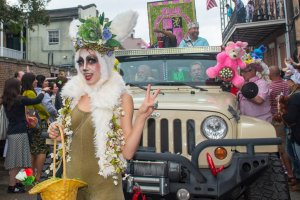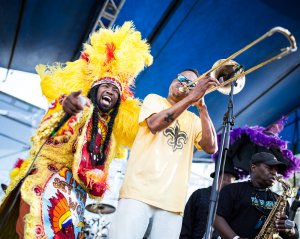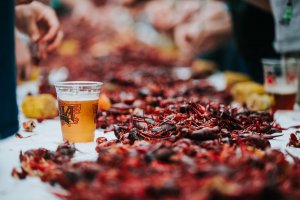French Speaking ‘Hommes de Couleur Libre’ Left Indelible Mark on the Culture and Development of the French Quarter
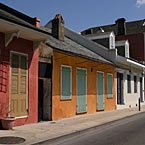
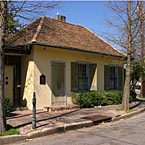
Top to Bottom: 933 Rue St. Philip, home of builder and community leader, Jean-Louis Dolliole; 1440 Rue Bourbon, another home built in 1819 by Dolliole
Jean-Louis Dolliole, 19th century builder and community leader, was the son of a Provencal Frenchman and Genevieve Laronde, a mother of African heritage. As a French-speaking free person of color or homme de couleur libre, Dolliole played an important role in developing and maintaining the culture and traditions of New Orleans. Serving also as testamentary executor, legal tutor or sponsor for friends and relatives, he helped to maintain the family lives and stature of the free black community. Best known as a talented builder along with his brother Joseph, Dolliole applied his skills to the creation of homes built and framed in the “French-style.” Using local materials like orange-red country brick and wood of cypress or pine, he drew largely on French building methods such as the triangular roof truss, half-timber construction, and the use of shingle, slate, or hook tile roofing or over lathing strips to fashion rooflines. Dolliole’s home in the French Quarter at 933 St. Philip represents the best of vernacular architecture. Built in 1805 and owned by Dolliole for a half century, it was rescued from near ruin by a skilled local architect and his wife, an historian and educator. And steps from Esplanade, Dolliole’s masterpiece at 1440 Bourbon stands on an irregular lot that reflects the crazy-quilt angles of the Faubourg Marigny. Here in 1819, Dolliole assembled the haunting lines of a softly-colored plastered brick cottage with a kaleidoscopic, double-pitched hipped roof of enduring flat tiles. To this day, the house is one of the most picturesque in the city.
Jean-Louis Dolliole was one of thousands of free people of color whose legacies survive in neighborhoods, church life, business, politics, music, writing and Francophone culture. Their records abound in local archives, dating from the 18th century until the Civil War and later. Among important builders were Pablo Cheval, Paul Mandeville, Bazile Dédé, August Philippe, Francois Darby, Charles Dupard, Manuel Moreau, Francois Boisdoré, Louis Barthelemy Rey, the Dollioles, Toby Dominique, Mytille Courcelle, Francois Fils, Florville Foy, Pierre Rillieux, and Joseph Chateau.
Joseph Chateau was one of the most prolific free black builders of the ante bellum period. His work has significance in a number of areas. New Orleans notaries of the 1840s recorded seventeen contracts documenting his building activities. Chateau’s stock-in-trade was the Creole cottage with a façade that was scored or floché to resemble stone, with decorative, red-hued painting. He also worked in other genres, building townhouses, renovating a store on Chartres St., and making innovations to the vernacular cottage. He responded creatively to his clients’ needs, such as getting a workable house built on a extra narrow lot, creating attractive rental property, tweaking space and a deeper footprint out of the traditional gable-sided cottage, and keeping up with fashion trends while preserving tradition. Chateau could also do drafting. While less than one per cent of building contracts have plans attached, over half of his have drawings, mainly floor plans that he executed with sophistication, and several with elevations.
Another profession, one called “merchant tailor,” was a niche and springboard for free men of color. Importing luxurious ells of silk, linen and Belgian Limbourg cloths, they fashioned high-style frock coats, cravats, vests, and pants for fastidious gentlemen, maintaining well-appointed storefronts with numerous employees. Several turned their profits into real estate investments. While still in their thirties Chartres Street merchant tailors Julien Colvis and Joseph Dumas owned 5 houses in the French Quarter, 21 in Tremé, 3 in the Marigny, 11 in the St. Mary Faubourg, and one in the town of Mandeville. On the same street, tailors Etienne Cordeviolle and Julien and Francois Lacroix amassed a fortune, and citywide holdings. Bourbon St. tailor Louis Barthelemy Rey formed a partnership with the land developer Victoria Lecesne. Victoria was wife of a man named Chazal Thomas, but identified her separate property in business dealings. It was not uncommon for free women of color to engage in business or build their own homes. Francoise Fusillé, Marie Laveau, Modest Foucher, Madeline Oger, Charlotte Morand, Rosette Rochon, Eulalie Mandeville, and Helene Toussaint, were among the many who records show built homes or engaged in business.
Today the spiritual heirs of the likes of Jean-Louis Dolliole, and Joseph Chateau celebrate their accomplishments. The old French names live on in their communities. Their legacy lives in the city’s fabric.
Sally Reeves is a noted writer and historian who co-authored the award winning series New Orleans Architecture. She also has written Jacques-Felix Lelièvre’s New Louisiana Gardener and Grand Isle of the Gulf – An Early History. She is currently working on a social and architectural history of New Orleans public markets and on a book on the contributions of free persons of color to vernacular architecture in antebellum New Orleans.


